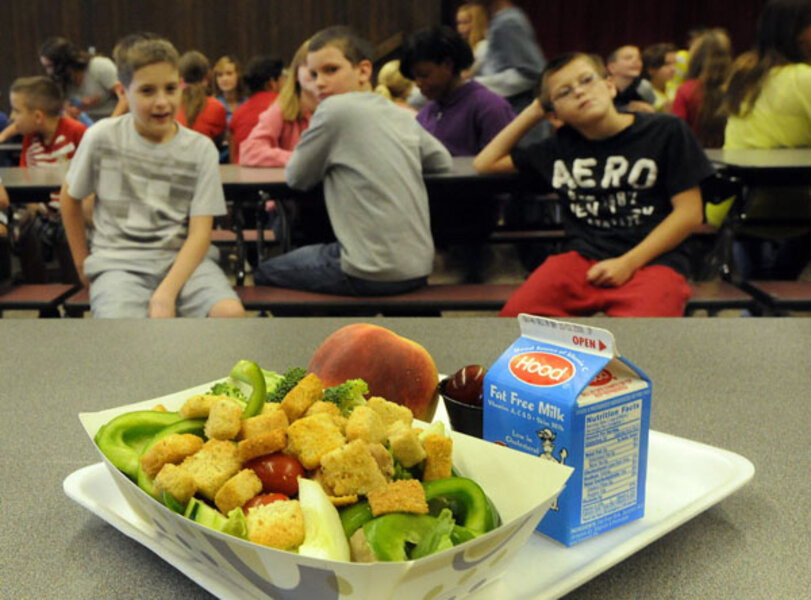School lunches: Students protest less portions, rising nutrition
Loading...
| MUKWONAGO, Wis.
By 7 a.m. Monday, senior Nick Blohm already had burned about 250 calories in the Mukwonago High School weight room.
He grabbed a bagel and a Gatorade afterward; if he eats before lifting, he gets sick.
RELATED: Are you a 'Helicopter Parent?' take our QUIZ!
That was followed by eight periods in the classroom, and then three hours of football practice. By the time he headed home, he had burned upward of 3,000 calories — his coach thinks the number is even higher.
But the calorie cap for his school lunch? 850 calories.
“A lot of us are starting to get hungry even before the practice begins,” Blohm said. “Our metabolisms are all sped up.”
Following new federal guidelines, school districts nationwide have retooled their menus to meet new requirements to serve more whole grains, only low-fat or nonfat milk, daily helpings of both fruits and vegetables, and fewer sugary and salty items. And for the first time, federal funds for school lunches mandate age-aligned calorie maximums. The adjustments are part of the Healthy, Hunger-Free Kids Act of 2010 touted by Michelle Obama and use the updated Dietary Guidelines for Americans from the U.S. Department of Agriculture.
The changes are hard to swallow for students like Blohm. On Monday, 70 percent of the 830 Mukwonago High students who normally buy lunch boycotted cafeteria food to protest what they see as an unfair “one size fits all thing.” Middle schoolers in the district also boycotted their school lunches, with counts down nearly half Monday. They’re not alone in their frustration; schools across the country are reporting students who are unhappy with the lunch offerings.
The sub sandwich line at Mukwonago High used to let students pile veggies on a six-inch French bread bun. Options now include a fist-sized whole wheat roll or multigrain wrap, and the once popular line is now mostly empty.
The healthier food is less the issue than the portions.
“A freshman girl who weighs 100 pounds can eat this lunch and feel completely full, maybe even a little bloated,” said Joey Bougneit, a Mukwonago, Wis., senior.
But Blohm is a 6-foot-3-inch, 210-pound linebacker. He’s also class president, and takes several Advanced Placement classes. If schools want students to perform well, he said, they can’t be sitting in their chairs hungry.
Last year’s fare featured favorites like chicken nuggets and mini corn dogs in helpings that were “relatively decent,” Bougneit said. But health-conscious regulations have changed that. Last week’s super nacho plate, for example, offered just eight tortilla chips.
Adding to the dissatisfaction is a 10-cent price hike on lunches because the USDA, which oversees the National School Lunch Program, forced many districts to raise full-price lunches closer to the $2.86 it reimburses for students who qualify for free lunches. That means the leaner, greener lunches at Mukwonago High this year now cost $2.50 instead of $2.40.
“Now it’s worse-tasting, smaller-sized and higher-priced,” Bougneit said.
Pam Harris, the district food service supervisor and a registered dietitian, said children’s weight and poor nutrition in America are serious problems, but the changes are too abrupt.
“I could not be more passionate about this,” Harris said. “I want to solve this problem. But limiting calories in school lunch is not going to help the overweight kid. What happens at home is a major piece of that puzzle.”
“Our issue is pretty much kids just don’t want to eat vegetables,” she said. “The USDA wants to solve the problem of childhood obesity. Those are two kind of separate issues.”
Harris spoke at all lunch periods recently to explain the federal dietary changes and had students fill out comment cards explaining what they do and don’t like about the new menu. She plans to send those andparent letters to the USDA in hopes the department will allow districts to gradually introduce their menu over a few years.
In a clothing store bag the size of a backpack, Blohm lugged his homemade, linebacker-size lunch including a bag of raw carrots, two ham sandwiches on wheat bread, two granola bars, an apple and three applesauce cups — an estimated total of 1,347 calories.
How long will the students keep boycotting the lunch program?
“I’ve already told my mom we might be packing my lunch for the rest of the year,” Blohm said.
Clay Iverson, Mukwonago’s varsity football head coach, said student-athletes are bigger, stronger and more athletic than ever before, and their food intake needs have evolved.
“Everything has been accelerated, and maybe nutrition hasn’t been,” he said.







